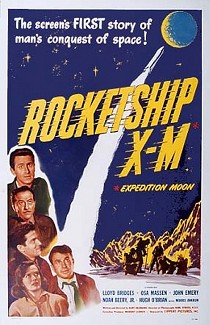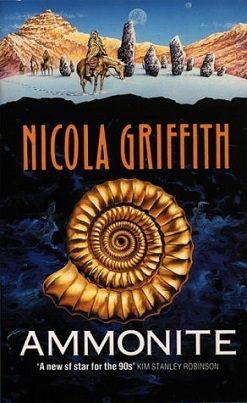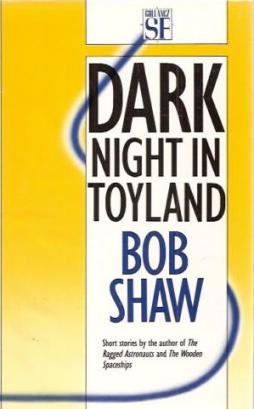
Dan Dare is a British science fiction comic hero, created by illustrator Frank Hampson who also wrote the first stories. Dare appeared in the Eagle comic series Dan Dare, Pilot of the Future from 1950 to 1967, and dramatised seven times a week on Radio Luxembourg (1951–1956).

An overwhelming majority of fiction is set on or features the Earth, as the only planet home to humans. This also holds true of science fiction, despite perceptions to the contrary. Works that focus specifically on Earth may do so holistically, treating the planet as one semi-biological entity. Counterfactual depictions of the shape of the Earth, be it flat or hollow, are occasionally featured. A personified, living Earth appears in a handful of works. In works set in the far future, Earth can be a center of space-faring human civilization, or just one of many inhabited planets of a galactic empire, and sometimes destroyed by ecological disaster or nuclear war or otherwise forgotten or lost.

Rocketship X-M is a 1950 American black-and-white science fiction film from Lippert Pictures, the first outer space adventure of the post-World War II era. The film was produced and directed by Kurt Neumann and stars Lloyd Bridges, Osa Massen, John Emery, Noah Beery Jr., Hugh O'Brian, and Morris Ankrum.

Ammonite is British-American author Nicola Griffith's debut novel, which was published in 1992. Styled as a meditation on queer ideologies, the novel explores themes of gender, illusion, and humanity. Griffith examines whether a world run by women would be a gentler or better one. American author Ursula Le Guin cited Ammonite as “a knock-out first novel, with strong, likeable characters, a compelling story, and a very interesting take on gender”.
"The Return of the Archons" is the twenty-first episode of the first season of the American science fiction television series Star Trek. Written by Boris Sobelman, and directed by Joseph Pevney, it first aired on February 9, 1967.
Angus MacVicar was a Scottish author with a wide-ranging output. His greatest successes came in three separate genres: crime thrillers, juvenile science fiction, and autobiography. His early writing was interrupted by wartime service with the Royal Scots Fusiliers, hence most of his fiction appeared in the two decades following World War II.

Subterranean fiction is a subgenre of adventure fiction, science fiction, or fantasy which focuses on fictional underground settings, sometimes at the center of the Earth or otherwise deep below the surface. The genre is based on, and has in turn influenced, the Hollow Earth theory. The earliest works in the genre were Enlightenment-era philosophical or allegorical works, in which the underground setting was often largely incidental. In the late 19th century, however, more pseudoscientific or proto-science-fictional motifs gained prevalence. Common themes have included a depiction of the underground world as more primitive than the surface, either culturally, technologically or biologically, or in some combination thereof. The former cases usually see the setting used as a venue for sword-and-sorcery fiction, while the latter often features cryptids or creatures extinct on the surface, such as dinosaurs or archaic humans. A less frequent theme has the underground world much more technologically advanced than the surface one, typically either as the refugium of a lost civilization, or as a secret base for space aliens.

Asteroids have appeared in fiction since at least the late 1800s, the first one—Ceres—having been discovered in 1801. They were initially only used infrequently as writers preferred the planets as settings. The once-popular Phaëton hypothesis, which states that the asteroid belt consists of the remnants of the former fifth planet that existed in an orbit between Mars and Jupiter before somehow being destroyed, has been a recurring theme with various explanations for the planet's destruction proposed. This hypothetical former planet is in science fiction often called "Bodia" in reference to Johann Elert Bode, for whom the since-discredited Titius–Bode law that predicts the planet's existence is named.

The Queen of Zamba is a science fiction novel by American writer L. Sprague de Camp, the first book of his Viagens Interplanetarias series and its subseries of stories set on the fictional planet Krishna. It was written between November 1948 and January 1949 and first published in the magazine Astounding Science Fiction as a two-part serial in the issues for August and September 1949. It was first published in book form as a paperback by Ace Books in 1954 as an "Ace Double" issued back-to-back with Clifford D. Simak's novel Ring Around the Sun. This version was editorially retitled Cosmic Manhunt and introduced a number of textual changes disapproved by the author. The novel was first issued by itself in another paperback edition under the title A Planet Called Krishna, published in England by Compact Books in 1966. A new paperback edition restoring the author's preferred title and text and including the Krishna short story "Perpetual Motion" was published by Dale Books in 1977. This edition was reprinted by Ace Books in 1982 as part of the standard edition of the Krishna novels. The novel has been translated into German, French, Italian, Czech, and Polish. An E-book edition was published by Gollancz's SF Gateway imprint on September 29, 2011 as part of a general release of de Camp's works in electronic form.
The fictional portrayal of the Solar System has often included planets, moons, and other celestial objects which do not actually exist. Some of these objects were, at one time, seriously considered as hypothetical planets which were either thought to have been observed, or were hypothesized to be orbiting the Sun in order to explain certain celestial phenomena. Often such objects continued to be used in literature long after the hypotheses upon which they were based had been abandoned.

Milcząca Gwiazda, literal English translation The Silent Star, is a 1960 East German/Polish color science fiction film based on the 1951 science fiction novel The Astronauts by Polish science fiction writer Stanisław Lem. It was directed by Kurt Maetzig, and stars Günther Simon, Julius Ongewe and Yoko Tani. The film was first released by Progress Film in East Germany, running 93 min. Variously dubbed and cut versions were also released in English under other titles: First Spaceship on Venus, Planet of the Dead, and Spaceship Venus Does Not Reply.

Flight to Mars is a 1951 American Cinecolor science fiction film drama, produced by Walter Mirisch for Monogram Pictures, directed by Lesley Selander, that stars Marguerite Chapman, Cameron Mitchell, and Arthur Franz.

The Viagens Interplanetarias series is a sequence of science fiction stories by L. Sprague de Camp, begun in the late 1940s and written under the influence of contemporary space opera and sword and planet stories, particularly Edgar Rice Burroughs's Martian novels. Set in the future in the 21st and 22nd centuries, the series is named for the quasi-public Terran agency portrayed as monopolizing interstellar travel, the Brazilian-dominated Viagens Interplanetarias. It is also known as the Krishna series, as the majority of the stories belong to a sequence set on a fictional planet of that name. While de Camp started out as a science fiction writer and his early reputation was based on his short stories in the genre, the Viagens tales represent his only extended science fiction series.

Ancient astronauts have been addressed frequently in science fiction and horror fiction. Occurrences in the genres include:

"Memory", formerly A World Called Maanerek, is a science fiction novelette by American writer Poul Anderson, first published in the July 1957 issue of Galaxy Science Fiction magazine.

The Lost Planet is a 1953 juvenile science fiction novelisation by Angus MacVicar, published by Burke, London. It is the first of the popular novel series The Lost Planet, which had orginally been written for radio and was later adapted for television

Dark Night in Toyland (ISBN 0-575-04448-9) is a collection of science fiction short stories by Bob Shaw, first published in 1989.
The Miracle-Workers is a science fiction novella by Jack Vance published in 1958. It was first published in Astounding Science Fiction in the July 1958 edition. It is about humans on an Earth-like planet which was colonized by space travellers many centuries ago. In the intervening years, the inhabitants have lost their understanding of science and have regressed to a Medieval state of technology, aided by their use of voodoo, telepathy, and magic. Change is set in motion when a maverick apprentice Jinxman starts to rediscover the scientific method and learn about science.

Project Mars: A Technical Tale is a science fiction novel by German-American rocket physicist, Wernher von Braun (1912–1977). It was written by von Braun in German in 1949 and entitled Marsprojekt. Henry J. White (1892–1962) translated the book into English and it was published later by Apogee Books (Canada) in 2006 as Project Mars: A Technical Tale, almost thirty years after von Braun's death. The original German text remains unpublished.















